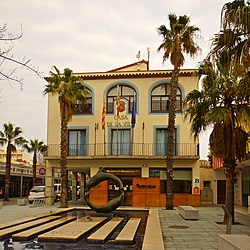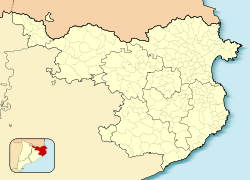Platja d'Aro
| Castell-Platja d'Aro | ||
|---|---|---|
| Municipality | ||

Town hall
|
||
|
||
| Location in Catalonia | ||
| Coordinates: 41°49′09″N 3°04′06″E / 41.81917°N 3.06833°E | ||
| Country |
|
|
| Community |
|
|
| Province | Girona | |
| Comarca | Baix Empordà | |
| Government | ||
| • Mayor | Joan Giraut Cot (2015) (CiU) | |
| Area | ||
| • Total | 21.8 km2 (8.4 sq mi) | |
| Elevation | 5 m (16 ft) | |
| Population (2014) | ||
| • Total | 10,721 | |
| • Density | 490/km2 (1,300/sq mi) | |
| Demonym(s) | Castellarenc; Platjarenc | |
| Website | www |
|
Castell-Platja d'Aro is a municipality in the middle of the Costa Brava in Catalonia, Spain. It is formed from two parts: Castell d'Aro is an ancient village built around a medieval castle and a fortified church, 3 km inland on the road from Platja d'Aro to Santa Cristina d'Aro; and Platja d'Aro is a coastal town on the road from Palamós to Sant Feliu de Guíxols which stretches along a large 2 km beach. Originally a small fishing village, Platja d'Aro is now a major coastal resort, popular predominantly with Catalans and villa-owning Northern Europeans.
Along the coast, connecting the main beach with numerous small beaches, is the Camí de Ronda.
Castell d'Aro is located in the heart of the Costa Brava, 80 km north of Barcelona. It borders with Calonge to the north, Santa Cristina d'Aro to the west, Sant Feliu to the south and the Coast to the East. Castell-Platja d'Aro occupies the eastern end of the Vall d'Aro, a narrow plain drained by the river Ridaura and located between the Mountain ranges of Cadiretes and southern end of the Gavarres. Platja d'Aro was originally a small fishing village on the highway between Palamós and Sant Feliu de Guíxols with a 2 km long beach. It is now a major tourist resort with hotels and other commercial premises.
The first evidence of human habitation are a number of tombs dating from the neolthic era 2500 BC in the Pinell area. Around 2000 BC, towards the end of the neolithic period, groups of humans settled in the mountains of Treumal and Vallvanera. There are a number of monuments from this period, including the menhir of Vallbanera and the dolmen Cova dels Moros ("Cove of the Moors").
Roman ruins were discovered at the Vila de Pla de Palol dating from the 1st-4th Centuries AD. These occupy an area of 10,000 m2, and retain the majority of the patios and open spaces. The villa was part of a large agricultural estate including vineyards. It also exported clay for the manufacture of ceramics that were later exported by sea from the natural harbor of Cove Rovira.
...
Wikipedia



